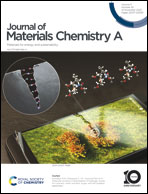Iodine dissolution mechanisms in high-pressure aluminoborosilicate glasses and their relationship to oxygen speciation†
Abstract
Incorporation of iodine(I) into high-pressure vitrified glasses appears to be a potential solution for the immobilization of 129I radioisotopes. Under these conditions, I dissolution is strongly enhanced; however, the impact I dissolution has on the glass structure remains to be determined to assess the matrix durability. We have experimentally studied the change in I solubility and speciation in a series of sodium aluminoborosilicate glasses (Na2O ranging from 10 to 40 mol%) held at 0.25 and 1.0 GPa and 1250 °C. As expected, the I solubility increases with pressure and with increasing Na2O and is positively correlated with the glass optical basicity. The I speciation determined by XPS is changing with the initial loaded source of iodine (either I2 or I2O5) with a predominant iodide form (I−) in the glass structure. The investigation of the oxygen environment in the I-bearing glasses using O 1s XPS revealed that I dissolution induces an apparent oxygen loss within the glass structure. This result is consistent with our current view on I dissolution mechanisms. Furthermore, the subsequent simulations of the O 1s XPS spectra suggest that I dissolution consumes non-bridging oxygen to form bridging oxygen. This change in the oxygen speciation points toward an increase in the glass durability, which is an important aspect for nuclear waste immobilization.



 Please wait while we load your content...
Please wait while we load your content...